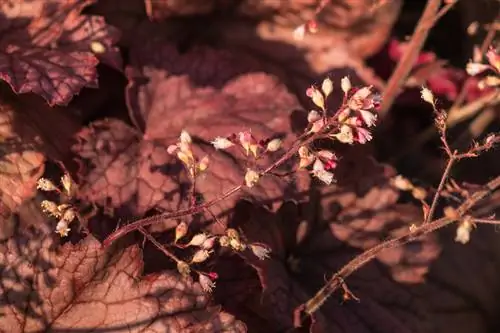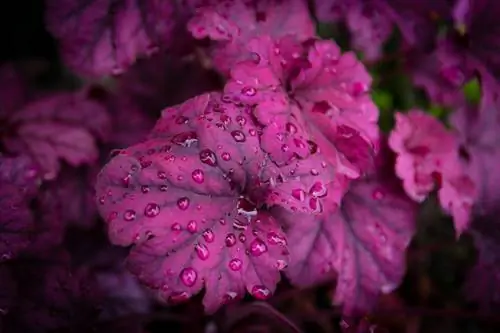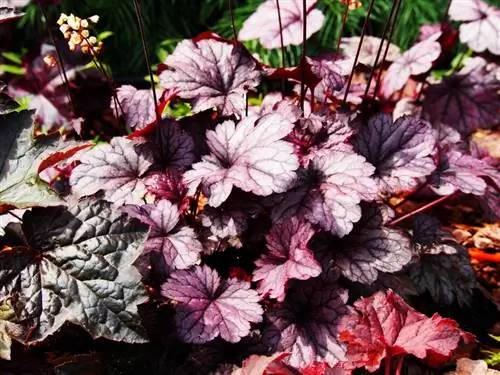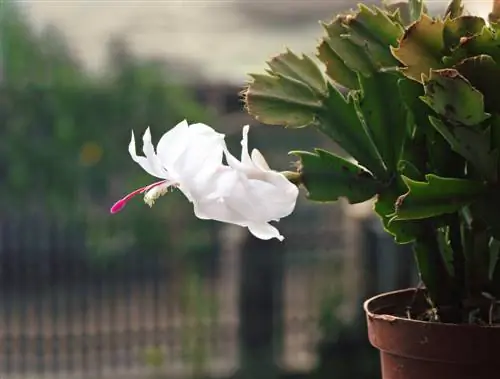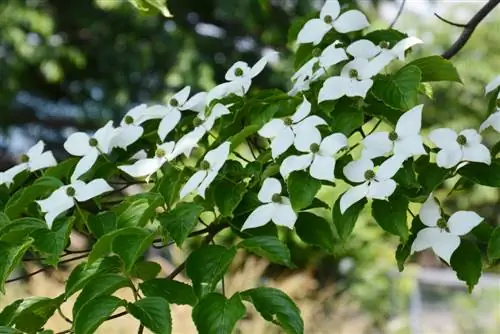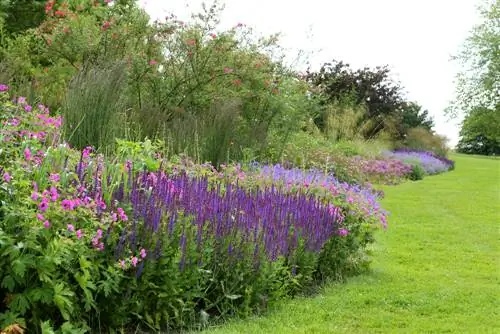- Author admin [email protected].
- Public 2023-12-25 17:45.
- Last modified 2025-01-23 11:20.
Evergreen purple bells enchant us with beautiful flower colors and pretty leaves that shimmer in wonderful color nuances. The immigrants from the mountains of North America and Mexico are well winter-hardy, so that as lavish perennials they decorate the garden with their beautiful flowers for many years. The following answers to common questions will familiarize you with proper cultivation.
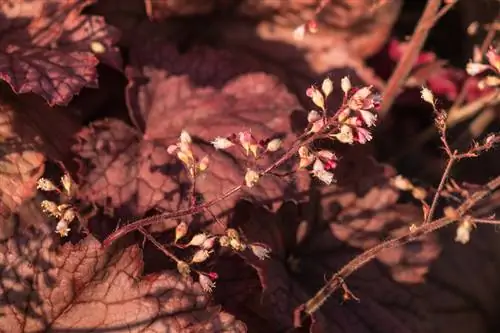
What are the characteristics and care requirements of purple bells?
Purple bells (Heuchera) are evergreen, hardy perennials that are characterized by colorful flowers, attractive foliage and a long flowering period from May to October. They prefer partially shaded locations, well-drained soil and require moderate water and occasional fertilizer.
Planting purple bells correctly
Careful soil preparation sets the stage for a long perennial life in a partially shaded location. Loosen the humus-rich, nutrient-rich soil thoroughly to enrich it with compost, horn shavings and rock dust. If in doubt, improve the permeability with sand, perlite or fine grit, because purple bells have no chance of survival in waterlogged conditions. Please plant the potted young plants a little deeper as the root balls often push upwards. Before mulching with leaves or grass clippings, water with normal tap water.
Care tips
Your purple bells pull out all the floral stops when given this care:
- Water moderately in dry conditions without soaking the soil
- Heap up rootstocks rising from the ground with compost
- Fertilize bedding perennials in March/April and June/July with compost, horn shavings and rock dust
- Fertilize liquidly in the pot every 4 weeks from May to September
- Clean out wilted flower stems regularly
- Cut back in autumn just above the wintergreen ornamental foliage
- Prune close to the ground in late winter, in good time before the new shoots
Modern Heuchera varieties have robust winter hardiness. We only recommend protection in the form of leaves, needle twigs or compost in exposed locations. Planters are not put away, but are given a winter coat made of jute, fleece or foil and a warm base made of wood or Styrofoam.read more
Which location is suitable?
Within the exuberant spectrum of magnificent species and varieties, you can discover the right purple bell for every design wish. Although the perennials differ in terms of height, flower and foliage color, they conform to the ideal location conditions. We have put together all the relevant criteria for you here:
- Sunlit to partially shaded location
- Fresh, well-drained and sandy-loamy soil
- A neutral to alkaline pH of 7.0 to 8.0
Don't expose your new favorite perennial to blazing sun or perpetual shade. Under these extreme conditions, the flowering takes place and the breathtaking foliage color fails to appear.read more
The correct planting distance
The clump-like, expansive habit of purple bells requires a generous planting distance so that the decorative effect can be clearly demonstrated. Arrange the perennials in the bed at a distance of 35-40 cm from each other. For cultivation in buckets and balcony boxes, please reduce this value by 5 cm. If you have intended Heuchera to serve as a decorative ground cover, plant 6-8 specimens per square meter.
What soil does the plant need?
Welcome your purple bells with nutrient-rich, humus-rich and well-drained soil. The ornamental perennials like to extend their roots in moderately dry to freshly moist soil that contains some lime. These fairly modest requirements make it easy for us to choose the substrate for pots and balcony boxes. A good compost-based potting soil meets expectations if it is enriched with a handful of perlite (€10.00 on Amazon), fine grit and rock dust.
What is the best time to plant?
Heuchera grown in containers can be planted throughout the entire growing season. The ideal planting time is August and September. At this time, young purple bells find ideal conditions in the warm soil for rapid rooting until winter.
When is flowering time?
From spring until well into autumn, purple bells set colorful accents in your garden and on the balcony. When combined correctly, the flowering period extends from May to October. Use the following overview of the most popular species for your inspiration:
- True purple bell (Heuchera sanguinea): flowering period from May to July
- Small-flowered purple bell (Heuchera micrantha): flowering period from June to September
- Pointed-leaved purple bell (Heuchera villosa): flowering period from July to October
Please remember that the decorative value of purple bells is by no means limited to the flower spikes. In the case of the most magnificent species, it is the breathtakingly colored leaves that captivate us with their iridescent nuances all year round.read more
Cut purple bells correctly
If you cut off the flowering stems down to the basal foliage, you can look forward to re-blooming. When the gardening year comes to an end, only withered flower stalks are cut off. Enjoy the impressive winter aspect of the decorative leaves until early spring. In February, cut the perennial plant close to the ground to make room for the fresh shoots.read more
Water purple bells
With their dense, evergreen foliage, purple bells require watering all year round. Check regularly using a thumb test to see whether the soil or substrate has dried out. Water the perennials only moderately, as waterlogging causes root rot within a short time and the plants die. Please note that even after a light summer rain, additional watering may be necessary as the raindrops do not reach the ground. If winter comes with cold frost, water Heuchera in the bed and pot on mild days.
Fertilize purple bells properly
When it comes to nutrient supply, purple bells are unexpectedly modest. In the bed, the magnificent perennials make do with compost, horn shavings and rock dust in March/April and again in June/July. Please only work the organic material into the soil superficially and then water. If Heuchera thrives in the planter, add a little liquid fertilizer to the irrigation water every month from May to September.
Wintering
As a typical saxifrage plant, purple bells are well hardy in Central Europe. Only in areas with very cold and long winters is protection from the cold outdoors recommended. Ideally, cover the perennial with a thick layer of leaves, secured with pine fronds. A protective layer of compost has also proven to be effective in gardening practice. Please do not take your Heuchera in a pot to a frost-free winter quarters. The plants need a cold period so that they can sprout again next spring. Instead, cover the container with bubble wrap and place it on a block of wood in front of the south wall of the house.
Propagate purple bells
The multifaceted species and variety of purple bells awakens our passion for collecting. In order to fulfill the desire for more specimens, these uncomplicated methods of propagation are available:
- Dividing the root ball in spring or autumn
- Cut head cuttings in summer to let them root in a small pot
- Harvesting the capsule fruits with the dark seeds and sowing behind glass from February
In contrast to vegetative propagation using division or cuttings, sowing can give you a headache. Some of the most beautiful varieties are sterile, so they do not produce seed heads. If you get hold of the seeds, it requires stratification. Only with a cold stimulus at temperatures between -4 and +4 degrees Celsius can the seeds be motivated to germinate.read more
How do I transplant correctly?
After 3-4 years, the vitality of purple bells noticeably dwindles. The flowers become more stunted and the previously bright leaf color becomes dull. Now is the time for a rejuvenation treatment. In the fall, pick up the root ball and divide it into segments with at least 2 buds. At the new location, the pieces are placed in soil prepared with compost and rock dust. If you then water abundantly and regularly, the rejuvenated perennials will root quickly.
Purple bells in the pot
In pots, purple bells transform partially shaded areas on balconies and terraces into colorful, evergreen retreats. In order for the plan to be successful, a drainage system made of potsherds underneath the well-drained substrate effectively prevents severe waterlogging. Please always water Heuchera in the planter when the soil surface has dried to a depth of 2-3 cm. Allow the water to gradually run onto the root ball. As soon as the coaster fills up, the current watering needs are covered. From May to September, monthly doses of liquid fertilizer give your flowering and foliage perennials a new lease of life. Please do not clear the pots as Heuchera rely on the cold stimulus of winter to induce flowers. Instead, place the containers on wood and wrap them with foil, fleece or jute ribbons. The withered flower stems are cut off down to the foliage. The leaves themselves are only cut back close to the ground shortly before new growth.
Is purple bell poisonous?
Beautify your family garden with peace of mind with non-toxic purple bells. No Heuchera species or variety poses a he alth risk to humans or animals.read more
Trivia
The high appreciation of the enchanting purple bell received a special recognition on December 4, 2014. On this day, the Deutsche Bundespost issued a new postage stamp as part of the flower series. Since then, the stamp with a value of 395 euro cents has been decorated with a depiction of a red-blooming purple bell.
Beautiful varieties
- Fireflies: Premium variety with spherical growth and scarlet flower spikes from June to July; Growth height 10-60 cm
- Berry Smoothie: Breathtakingly beautiful silver bell with iridescent, berry-colored foliage and white flowers; 50-60cm
- Plum Pudding: sighting winner with wavy, plum-purple leaves and pink-white flowers; 50-60cm
- Autumn Leaves: Delights with foliage coloring from light red to peach to wine red throughout the year; 40-50cm
- Silver Streak: A salmon pink flower rises above the bronze-colored, silvery shimmering leaves; 30-40cm
- Sweet Tea: Fantastically beautiful with tea-colored, silvery heart leaves and cream-colored flower spikes; 40-50cm
- Shanghai: Waits with dark purple, maple-shaped leaves under delicate, white bell-shaped flowers; 25-40cm
- Solar Eclipse: The red-brown heart leaves are decorated with a neon green edge; a feast for the eyes in beds and containers; 40-50cm
- Tiramisu: noble hybrid whose creamy white flowers rise above yellow, rust-red leaves; 40-50cm

